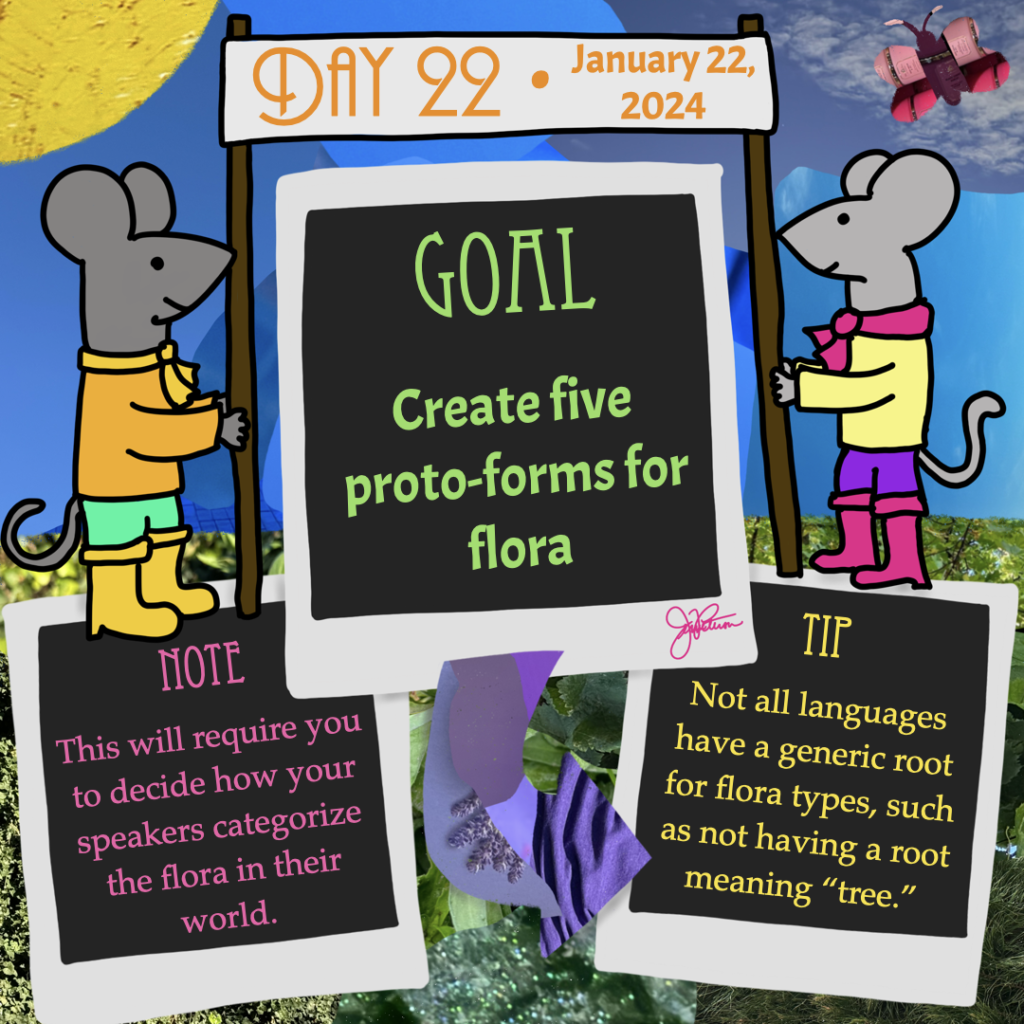
Goal: Create five proto-forms for flora
Note: This will require you to decide how your speakers categorize the flora in their world.
Tip: Not all languages have a generic root for flora types, such as not having a root meaning “tree.”
Work focus: Create/Make/List
You spent time outlining features of your conworld, including the kinds of flora native to the area where your speakers live. Now you need to decide which of those flora types you want to assign roots to and create roots for at least five of them. As you consider your options, remember that not all languages share the same basic vocabulary, even if their speakers live in relatively similar areas. For instance, if your speakers live in a forested area, they will be surrounded by trees and will have ways to refer to them. You can decide if your language will have a word simply meaning “tree,” which gets applied to all trees, whether they are oaks, pines, cedars, or dogwoods.
However, you could also choose to have a series of basic roots assigned to specific types of trees, such as having a distinct root meaning “oak tree” and another “pine tree” and another “dogwood tree” and so on. In that case, your speakers may develop a generic way to refer to trees as a larger category, but the language includes some very specific ways to refer to types of trees all the way back to the proto-stages.
You could, of course, do a mix of the two strategies. For instance, English has the basic word “tree” (a generic word for any tree) but also has “oak,” “birch,” and “beech” as basic roots for specific types of trees. (Other tree names are the results of compounds and derivations, such as dogwood, cherry blossom, and sapling.) There’s no wrong way to assign these forms—it’s a matter of deciding how you want to categorize the conworld as you assign labels that will refer to some types of flora and not others.
One reason I assigned so many days to creating proto-forms was to spread out word creation to give you time to review the forms you’re coming up with. As you create forms, continue to consider your sound system and update it if you want to make any changes to it, whether you want to add sounds, take sounds away, change the syllable structures, or shift the way stress is assigned. These days of creation give you time to work within the system you’ve set up so far to make sure you’re happy with it.
These days are also time for you to work on a system of documentation to find the best way for you to keep track of your language’s growing lexicon. For some, a spreadsheet is the best option. For others, like me, a document written in the style of a dictionary is the best option. Figure out what works for you and make sure you document all these forms you’re creating in one place.
As you review the forms you’ve already created and the ones you add today, look to see if there are any gaps in the way you’re using sounds. For instance, are there any consonants you have not yet used in the onset position? An allowable consonant coda you haven’t yet used? A consonant cluster combination you’ve overlooked so far? Try to use a variety of your sounds in these initial forms to continue working with your chosen system and to find if there are areas you want to change.
Also, it’s best to create unique proto-forms for these words, so having a good way to document all the forms in one place gives you the chance to make sure the root forms are new. While languages have homonyms/homophones, they are typically the result of language evolution. For the proto-stages, it’s good to have unique roots. (And later on, you might be surprised by the homophones created by the sound changes you select and implement!)
